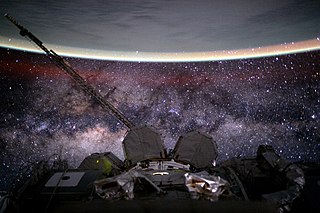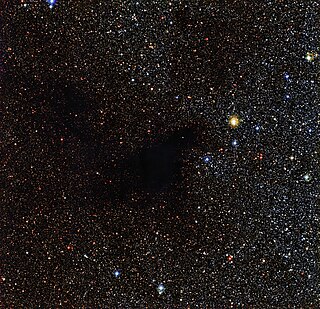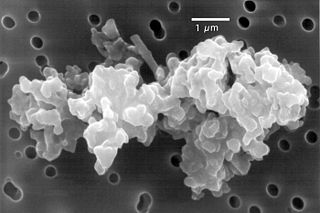Related Research Articles

An Interstellar Cloud is generally an accumulation of gas, plasma, and dust in our and other galaxies. Put differently, an interstellar cloud is a denser-than-average region of the interstellar medium, the matter and radiation that exists in the space between the star systems in a galaxy. Depending on the density, size, and temperature of a given cloud, its hydrogen can be neutral, making an H I region; ionized, or plasma making it an H II region; or molecular, which are referred to simply as molecular clouds, or sometime dense clouds. Neutral and ionized clouds are sometimes also called diffuse clouds. An interstellar cloud is formed by the gas and dust particles from a red giant in its later life.

A molecular cloud, sometimes called a stellar nursery (if star formation is occurring within), is a type of interstellar cloud, the density and size of which permit absorption nebulae, the formation of molecules (most commonly molecular hydrogen, H2), and the formation of H II regions. This is in contrast to other areas of the interstellar medium that contain predominantly ionized gas.

A nebula is a distinct luminescent part of interstellar medium, which can consist of ionized, neutral, or molecular hydrogen and also cosmic dust. Nebulae are often star-forming regions, such as in the "Pillars of Creation" in the Eagle Nebula. In these regions, the formations of gas, dust, and other materials "clump" together to form denser regions, which attract further matter and eventually become dense enough to form stars. The remaining material is then thought to form planets and other planetary system objects.

The following outline is provided as an overview and topical guide to space science:
Cosmic noise, also known as galactic radio noise, is a physical phenomenon derived from outside of the Earth's atmosphere. It is not actually sound, and it can be detected through a radio receiver, which is an electronic device that receives radio waves and converts the information given by them to an audible form. Its characteristics are comparable to those of thermal noise. Cosmic noise occurs at frequencies above about 15 MHz when highly directional antennas are pointed toward the Sun or other regions of the sky, such as the center of the Milky Way Galaxy. Celestial objects like quasars, which are super dense objects far from Earth, emit electromagnetic waves in their full spectrum, including radio waves. The fall of a meteorite can also be heard through a radio receiver; the falling object burns from friction with the Earth's atmosphere, ionizing surrounding gases and producing radio waves. Cosmic microwave background radiation (CMBR) from outer space is also a form of cosmic noise. CMBR is thought to be a relic of the Big Bang, and pervades the space almost homogeneously over the entire celestial sphere. The bandwidth of the CMBR is wide, though the peak is in the microwave range.

Galactic astronomy is the study of the Milky Way galaxy and all its contents. This is in contrast to extragalactic astronomy, which is the study of everything outside our galaxy, including all other galaxies.

Astronomy is a natural science that studies celestial objects and the phenomena that occur in the cosmos. It uses mathematics, physics, and chemistry in order to explain their origin and their overall evolution. Objects of interest include planets, moons, stars, nebulae, galaxies, meteoroids, asteroids, and comets. Relevant phenomena include supernova explosions, gamma ray bursts, quasars, blazars, pulsars, and cosmic microwave background radiation. More generally, astronomy studies everything that originates beyond Earth's atmosphere. Cosmology is a branch of astronomy that studies the universe as a whole.

In astronomy, the interstellar medium (ISM) is the matter and radiation that exists in the space between the star systems in a galaxy. This matter includes gas in ionic, atomic, and molecular form, as well as dust and cosmic rays. It fills interstellar space and blends smoothly into the surrounding intergalactic space. The energy that occupies the same volume, in the form of electromagnetic radiation, is the interstellar radiation field. Although the density of atoms in the ISM is usually far below that in the best laboratory vacuums, the mean free path between collisions is short compared to typical interstellar lengths, so on these scales the ISM behaves as a gas (more precisely, as a plasma: it is everywhere at least slightly ionized), responding to pressure forces, and not as a collection of non-interacting particles.

Astrochemistry is the study of the abundance and reactions of molecules in the universe, and their interaction with radiation. The discipline is an overlap of astronomy and chemistry. The word "astrochemistry" may be applied to both the Solar System and the interstellar medium. The study of the abundance of elements and isotope ratios in Solar System objects, such as meteorites, is also called cosmochemistry, while the study of interstellar atoms and molecules and their interaction with radiation is sometimes called molecular astrophysics. The formation, atomic and chemical composition, evolution and fate of molecular gas clouds is of special interest, because it is from these clouds that solar systems form.

Outer space is the expanse beyond celestial bodies and their atmospheres. It contains ultra-low levels of particle densities, constituting a near-perfect vacuum of predominantly hydrogen and helium plasma, permeated by electromagnetic radiation, cosmic rays, neutrinos, magnetic fields and dust. The baseline temperature of outer space, as set by the background radiation from the Big Bang, is 2.7 kelvins.

Onsala Space Observatory (OSO), the Swedish National Facility for Radio Astronomy, provides scientists with equipment to study the Earth and the rest of the Universe. The observatory operates two radio telescopes in Onsala, 45 km south of Gothenburg, and takes part in several international projects. Examples of activities:

In astronomy, extinction is the absorption and scattering of electromagnetic radiation by dust and gas between an emitting astronomical object and the observer. Interstellar extinction was first documented as such in 1930 by Robert Julius Trumpler. However, its effects had been noted in 1847 by Friedrich Georg Wilhelm von Struve, and its effect on the colors of stars had been observed by a number of individuals who did not connect it with the general presence of galactic dust. For stars lying near the plane of the Milky Way which are within a few thousand parsecs of the Earth, extinction in the visual band of frequencies is roughly 1.8 magnitudes per kiloparsec.

Cosmic dust – also called extraterrestrial dust, space dust, or star dust – is dust that occurs in outer space or has fallen onto Earth. Most cosmic dust particles measure between a few molecules and 0.1 mm (100 μm), such as micrometeoroids. Larger particles are called meteoroids. Cosmic dust can be further distinguished by its astronomical location: intergalactic dust, interstellar dust, interplanetary dust, and circumplanetary dust. There are several methods to obtain space dust measurement.

Atomic astrophysics is concerned with performing atomic physics calculations that will be useful to astronomers and using atomic data to interpret astronomical observations. Atomic physics plays a key role in astrophysics as astronomers' only information about a particular object comes through the light that it emits, and this light arises through atomic transitions.

The Cosmic Origins Spectrograph (COS) is a science instrument that was installed on the Hubble Space Telescope during Servicing Mission 4 (STS-125) in May 2009. It is designed for ultraviolet (90–320 nm) spectroscopy of faint point sources with a resolving power of ≈1,550–24,000. Science goals include the study of the origins of large scale structure in the universe, the formation and evolution of galaxies, and the origin of stellar and planetary systems and the cold interstellar medium. COS was developed and built by the Center for Astrophysics and Space Astronomy (CASA-ARL) at the University of Colorado at Boulder and the Ball Aerospace and Technologies Corporation in Boulder, Colorado.

The warm–hot intergalactic medium (WHIM) is the sparse, warm-to-hot (105 to 107 K) plasma that cosmologists believe to exist in the spaces between galaxies and to contain 40–50% of the baryonic 'normal matter' in the universe at the current epoch. The WHIM can be described as a web of hot, diffuse gas stretching between galaxies, and consists of plasma, as well as atoms and molecules, in contrast to dark matter. The WHIM is a proposed solution to the missing baryon problem, where the observed amount of baryonic matter does not match theoretical predictions from cosmology.

A dust lane consists of relatively dense, obscuring clouds of interstellar dust, observed as a dark swath against the background of brighter object(s), especially a galaxy. These dust lanes can usually be seen in spiral galaxies, such as the Milky Way, when viewed from the edge. Due to the dense and relatively thick nature of this dust, light from the galaxy is reduced by several magnitudes. In the Milky Way, this attenuation of visible light makes it impossible to see the stars behind the Great Rift through the bulge around the Galactic Center from Earth. This dust, as well as the gasses also found within these lanes, mix and combine to form stars and planets.

An intergalactic star, also known as an intracluster star or a rogue star, is a star not gravitationally bound to any galaxy. Although a source of much discussion in the scientific community during the late 1990s, intergalactic stars are now generally thought to have originated in galaxies, like other stars, before being expelled as the result of either galaxies colliding or of a multiple-star system traveling too close to a supermassive black hole, which are found at the center of many galaxies.
This glossary of astronomy is a list of definitions of terms and concepts relevant to astronomy and cosmology, their sub-disciplines, and related fields. Astronomy is concerned with the study of celestial objects and phenomena that originate outside the atmosphere of Earth. The field of astronomy features an extensive vocabulary and a significant amount of jargon.
The Polaris Flare is a filamentous gas cloud in the Milky Way which is seen in the sky in the region of the constellation Ursa Minor and around the star Polaris. The area on the sky is estimated at 50 square degrees. The range is approximately 500 light years.
References
- 1 2 3 4 5 6 M. E. Bailey; D. A. Williams (1988). Dust in the universe: the proceedings of a conference at the Department of Astronomy, University of Manchester, 14–18 December 1987. CUP Archive. p. 509. ISBN 978-0-521-35580-3.
- ↑ Atkinson, Nancy (February 26, 2009). "Intergalactic Dust Could Be Messing Up Observations, Calculations". Universe Today. Retrieved December 13, 2021.
- ↑ "New Images From Euclid Mission Reveal Wide View of the Dark Universe".
